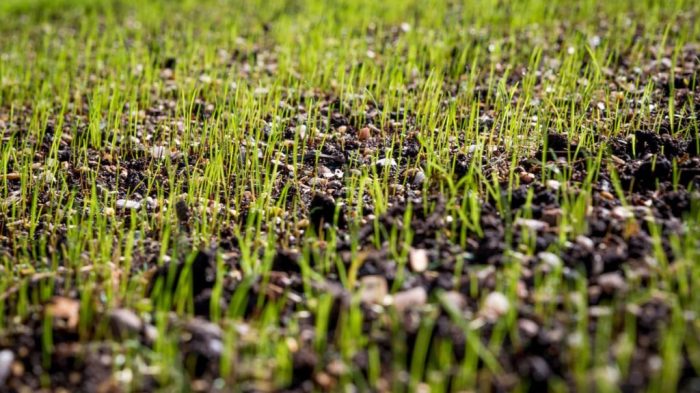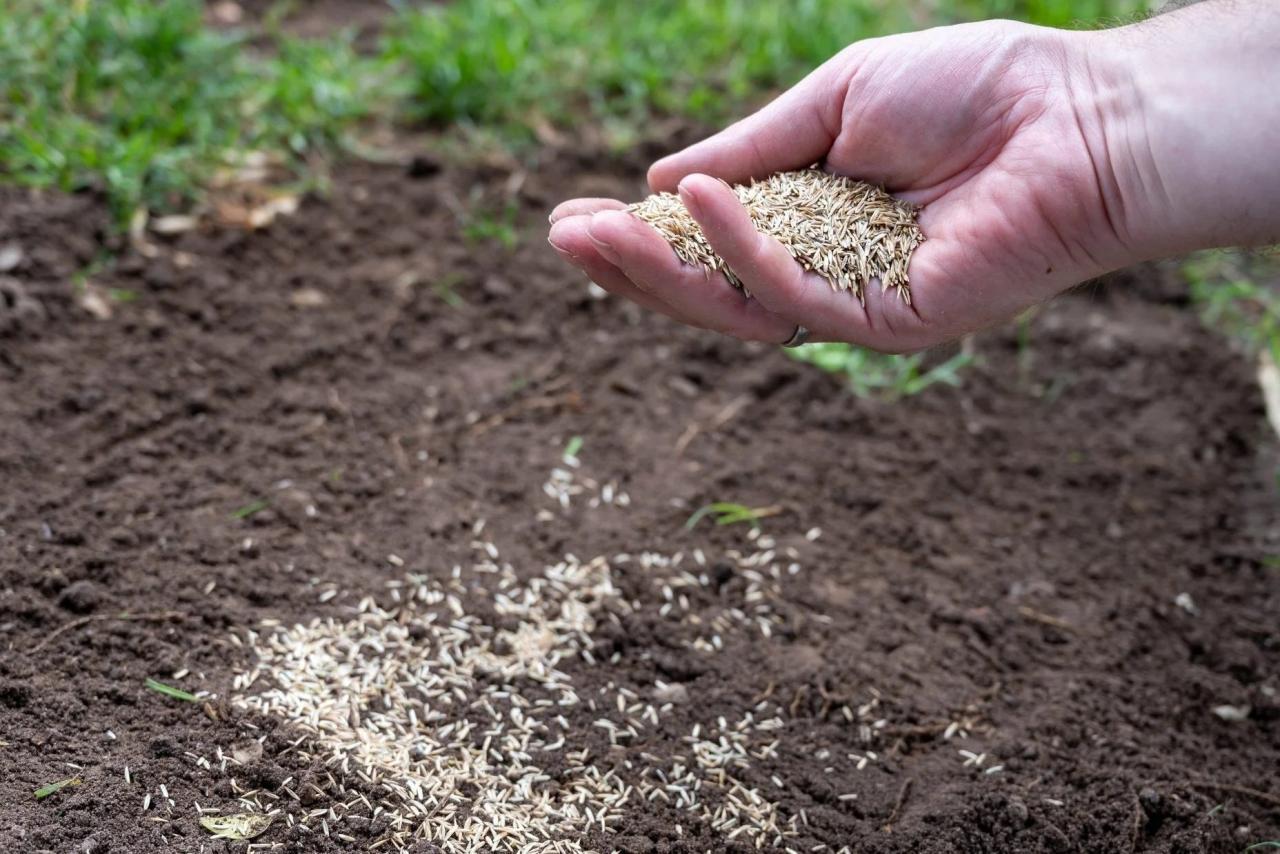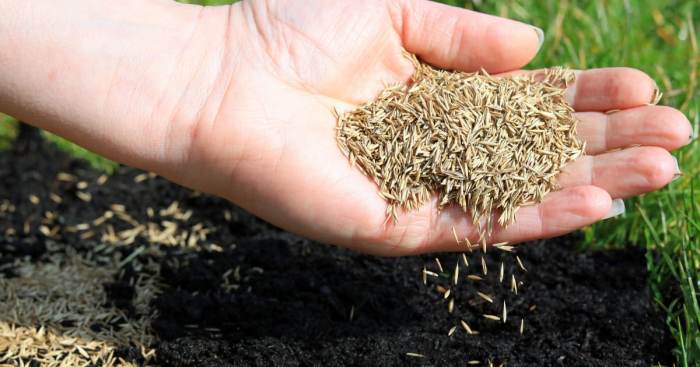When Can Grass Seed Be Planted?
Ideal Timing for Planting Grass Seed
When can grass seed be planted – The success of your lawn hinges significantly on when you plant your grass seed. Timing is crucial, as it directly impacts germination rates, seedling establishment, and the overall health of your new lawn. Optimal planting times vary depending on your climate zone and the type of grass seed you choose. Generally, spring and fall offer the best conditions, but the specific window differs across regions.
Optimal Planting Times Based on Climate Zones
Cool-season grasses (like fescue, ryegrass, and bluegrass) thrive in cooler temperatures and are best sown in early spring or fall. Warm-season grasses (like Bermuda, Zoysia, and St. Augustine) prefer warmer soil and air temperatures and are ideally planted in late spring or early summer.
Spring vs. Fall Planting: A Comparison
| Feature | Spring Planting | Fall Planting |
|---|---|---|
| Ideal Climate Zones | Cooler regions with moderate rainfall | Most climate zones, particularly those with mild winters |
| Advantages | Longer growing season for establishment; warmer temperatures aid germination | Cooler temperatures reduce weed competition; moisture levels are often higher |
| Disadvantages | Competition from weeds; potential for drought stress during establishment | Slower germination; risk of frost damage in colder climates |
Specific Planting Dates for Various US Regions
Precise planting dates depend on local weather patterns and soil temperatures. As a general guideline, consult your local agricultural extension office for the most accurate information. However, here’s a rough estimate for some major regions:
- Northeast: Spring (April-May), Fall (September-October)
- Southeast: Spring (March-April), Fall (September-October)
- Midwest: Spring (April-May), Fall (August-September)
- Southwest: Fall (September-October) is generally preferred due to heat.
- West Coast: Timing varies greatly depending on the specific region and microclimate. Consult your local resources.
Soil Temperature and Grass Seed Germination
Soil temperature plays a vital role in grass seed germination. Different grass types have different optimal temperature ranges for germination. Monitoring soil temperature is crucial for successful planting.
Ideal Soil Temperature Ranges for Germination
Cool-season grasses generally germinate best in soil temperatures between 50-65°F (10-18°C), while warm-season grasses require warmer soil, typically between 65-80°F (18-27°C). Germination slows significantly outside these ranges.
Measuring Soil Temperature
A soil thermometer is the most accurate method for measuring soil temperature. Insert the thermometer probe into the soil at the desired depth (typically 2-4 inches). Several types of soil thermometers are available, including dial thermometers and digital thermometers with probes.
Impact of Soil Temperature on Germination
Soil temperatures below the optimal range result in slow or inhibited germination. Conversely, temperatures that are too high can damage the seed or lead to rapid dehydration, hindering establishment. Maintaining the ideal soil temperature range is critical for ensuring successful germination and vigorous seedling growth.
Soil Preparation for Grass Seed Planting
Proper soil preparation is essential for a healthy, thriving lawn. This involves several steps, from testing and amending to leveling the area. Careful preparation ensures optimal conditions for seed germination and root development.
Step-by-Step Soil Preparation Guide
- Soil Test: Conduct a soil test to determine the pH and nutrient levels. This provides a baseline for amending the soil.
- Amending: Based on the soil test results, add necessary amendments such as compost, peat moss, or fertilizer to improve soil structure, drainage, and nutrient content.
- Tilling: Till or loosen the soil to a depth of 4-6 inches to break up compacted soil and improve aeration.
- Leveling: Rake the soil to create a smooth, level surface for even seed distribution.
- Removing Debris: Remove rocks, sticks, and other debris that could interfere with germination.
Essential Soil Amendments
- Compost: Improves soil structure, drainage, and nutrient content.
- Peat Moss: Improves soil drainage and aeration, especially in heavy clay soils.
- Fertilizer: Provides essential nutrients for seedling growth.
- Lime: Raises soil pH in acidic soils.
Soil Preparation Techniques
| Technique | Pros | Cons |
|---|---|---|
| Tilling | Effective for breaking up compacted soil; improves aeration | Can damage soil structure if overdone; can bring weed seeds to the surface |
| No-Till | Preserves soil structure; reduces erosion; minimizes weed seed disturbance | Less effective for compacted soils; may require more amendments |
Watering and Aftercare for Newly Planted Grass Seed

Source: sodsolutions.com
Consistent and proper watering is critical for successful grass seed germination and establishment. The frequency and depth of watering should be adjusted based on weather conditions and soil moisture levels. Proper aftercare helps prevent common problems.
Proper Watering Techniques
Water gently and deeply to ensure the seeds are adequately hydrated. Avoid heavy watering, which can wash away the seeds or lead to soil compaction. Aim for consistent moisture, but not waterlogged conditions. A light misting is better than infrequent deep watering.
Watering Schedule
During dry weather, water more frequently, potentially daily, to maintain soil moisture. In wet conditions, reduce watering frequency to prevent overwatering. Monitor soil moisture regularly and adjust watering accordingly.
Preventing Common Problems

Source: familyhandyman.com
- Disease: Ensure proper spacing during planting to allow for good air circulation, reducing disease risk. Avoid overwatering, which can promote fungal diseases.
- Weed Infestation: Pre-emergent herbicides can be used before planting to control weeds. Regular weeding after germination is crucial to prevent weed competition.
- Pest Infestation: Monitor for pests and take appropriate action if necessary. Contact your local agricultural extension for advice on pest control.
Choosing the Right Grass Seed
Selecting the appropriate grass seed is crucial for a successful lawn. Consider factors such as climate, sun exposure, and desired characteristics when making your choice. Using a seed mix can provide benefits over a single type.
Comparing Grass Seed Types
Cool-season grasses are better suited for cooler climates, while warm-season grasses thrive in warmer regions. Shade tolerance, drought tolerance, and wear resistance are other important factors to consider. For example, fescue is known for its shade tolerance, while Bermuda grass excels in heat and drought.
Key Characteristics to Consider
- Drought Tolerance: Important for regions with limited rainfall.
- Shade Tolerance: Necessary for areas with limited sunlight.
- Wear Resistance: Crucial for high-traffic areas.
- Disease Resistance: Reduces the risk of disease outbreaks.
Seed Mix vs. Single Grass Type
Seed mixes offer diversity, providing resilience against diseases and varying environmental conditions. A single grass type may be more susceptible to disease or stress if conditions are not ideal. A mix usually provides a more aesthetically pleasing, fuller lawn.
Visual Guide to Grass Seed Planting: When Can Grass Seed Be Planted
Observing the visual cues during each stage of grass seed planting and growth helps you identify potential issues and ensure a healthy lawn. Understanding the visual changes provides valuable feedback on your planting and aftercare.
The ideal time to plant grass seed depends on your climate, generally in spring or fall. However, if you’re interested in aquatic plants, the principles of timing are quite different; for example, learning how to properly plant lotus flower seeds, as described in this helpful guide: how to plant lotus flower seeds , requires a warmer season. Returning to grass, successful germination hinges on consistent moisture and suitable temperatures.
Healthy Grass Seedlings

Source: lawnchick.com
Healthy seedlings initially appear as a vibrant green, emerging from the soil within a few weeks. Their color deepens as they mature, and their height gradually increases. The overall appearance should be uniform and dense, indicating successful germination and establishment. Expect to see a consistent density across the planted area.
Signs of Poor Germination or Unhealthy Seedlings
Sparse growth, yellowing or browning of seedlings, stunted growth, and patchy areas indicate potential problems. These could be due to poor soil preparation, inadequate watering, disease, or pest infestations. Thin areas may require reseeding.
Visual Stages of Soil Preparation, When can grass seed be planted
The initial tilling creates a loose, brown soil texture. After amending, the soil may appear darker and richer. The final raking results in a smooth, level surface, ready for seeding. The prepared soil should appear consistently loose and level across the planting area.
General Inquiries
What happens if I plant grass seed at the wrong time?
Planting at the wrong time can lead to poor germination rates, weak seedlings, and increased susceptibility to disease. The seeds may not germinate at all, or the seedlings may struggle to establish strong root systems, resulting in a patchy or thin lawn.
How deep should I plant grass seed?
Generally, grass seed should be planted at a depth of about twice the seed’s diameter. For most grasses, this is typically around 1/4 to 1/2 inch.
Can I overwater newly planted grass seed?
Yes, overwatering can lead to fungal diseases and prevent proper germination. Aim for consistent moisture but avoid saturating the soil.
What are the signs of healthy grass seedlings?
Healthy seedlings are typically a vibrant green color, grow uniformly, and have strong, established root systems. Look for consistent growth and the absence of yellowing or browning.





















